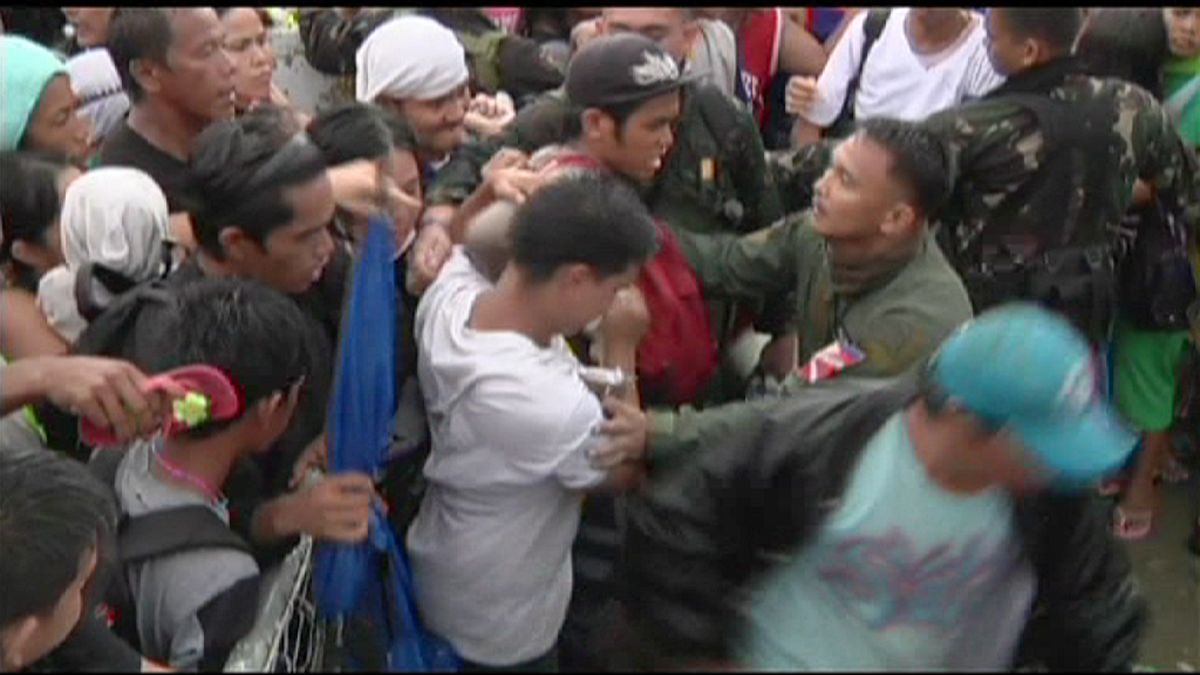Officials in the central Philippines are still overwhelmed in the aftermath of Typhoon Haiyan. In Tacloban, corpses lay uncollected. Desperate townspeople scavenge through debris. The country’s interior secretary said Tacloban’s municipal government was wiped out by the storm, or officials were dead, missing or debilitated by grief.
Petrol is as scarce as food and clean drinking water.
An emergency coordinator with Médecins Sans Frontières said the destruction was like after a massive earthquake followed by huge floods”.
Most stores remain closed – either destroyed or shut after widespread looting.
A resident eyewitness we spoke with by phone said: “I was riding my bicycle in Tacloban, taking pictures with my camera, and I saw people going into a shopping mall. I was curious so I followed them in and saw them stealing not only food but also clothes, shoes, watches, televisions and laptops.”
Of the city’s fewer than 300 policemen, the country’s interior secretary said only 20 had shown up for duty. President Aquino has deployed hundreds of soldiers in Tacloban.
We also heard this report from a resident: “Our most important need of course is water and food. There is no water. There is a lack of food. We barely eat. Safety… I have heard that thieves have [broken] into houses. There have been gunshots, People are killing each other. There’s talk about rapes, no police, no order, no information from the people outside Tacloban – nothing. It’s total chaos!”
Air Force cargo planes landed more soldiers than relief supplies at Tacloban airport as the week began, underscoring concerns about civil disorder. Some sick people, children and the elderly were flown out to Manila.
Laurence Alexandrowicz, in our Lyon studio, asked Elisabeth Byrs, with the World Food Programme in Geneva: “Before we talk about aid, do we have an idea from the United Nations about the number of people killed in the Philippines? There is talk of ten thousand; might it be more? And also many dramatically injured?”
Elisabeth Byrs, UN World Food Programme: “It is very difficult to get an exact estimate. But early assessments have been made for Tacloban and the region. There are nearly 7,000 small islands up a 600-kilometer stretch, and the coast was scoured. I don’t think we’ll know for quite a while, until help has been able to reach far-away, isolated places. And out priority is the survivors.”
euronews: “The UN food agency is in the front line fighting hunger; what are the first things that happen when there’s an emergency?”
Byrs: “Even before the typhoon made landfall, we had launched consignments of high energy biscuits and of two thousand tonnes of rice. On Monday, 44 tonnes of those biscuits had arrived in Tacloban. We sent that food assistance, especially the biscuits, so they could be eaten immediately, without needing to be cooked or prepared. They provide survivors with the vitamins they need to hold on. With the 44 tonnes that got there we were able to feed 120,000 people. There’s another 161 tonnes on its way. There’s an air bridge between our warehouses in Dubai, Manilla and Tacloban, and with this first wave of food we hope we can help the survivors get through the first week.”
euronews: “With the logistical obstacles and looting that we’ve been talking about in our broadcasts, considering the Philippines is made up of thousands of islands, as you say, how will you manage?”
Byrs: “I think it’s going to be a nightmare for logistics, a real challenge for the humanitarian agencies. There’s so much destruction. As soon as we have to cut down a tree or a pylon, it slows us down. It’s 11 kilometers from Tacloban airport to the centre of town. It’s taking six hours to cover that distance, so that gives us some idea what’s involved distributing assistance, how difficult it is.”
euronews: “This disaster is a tragic reminder of the Indian Ocean Tsunami in 2004. At the time agencies were said to be competing; did you learn lessons from that?”
Byrs: “The parallel was drawn when the first experts arrived on site, because the damage and ravaged landscape resembled 2004 so exactly, what they saw after the tsunami in Banda Acé in Indonesia. But that’s where the comparison stops, I think. After any disaster, the UN and NGOs learn, and the main lesson is not to be hasty. Logistics have to be well-organised to be more effective, to avoid having too many people rushing to the site, which creates a burden for coordination. When that is well done, well, I hope we really can be the most efficient that’s possible. But, again, in a context like this we need to admit it’s going to be quite hard.”
euronews: “Lastly here, you’re launching calls for donations; how can we participate as individual citizens?”
Byrs: “Our donation drive has been launched on the website wfp.org/typhoon. Anyone can give, even small amounts.”
